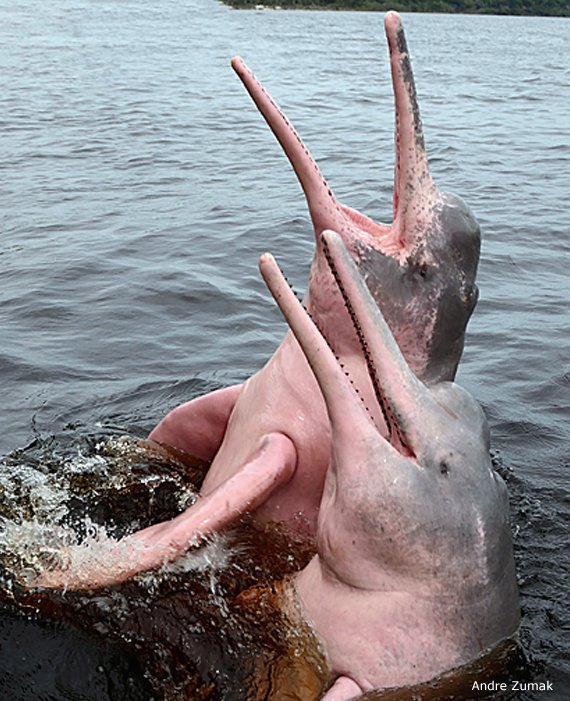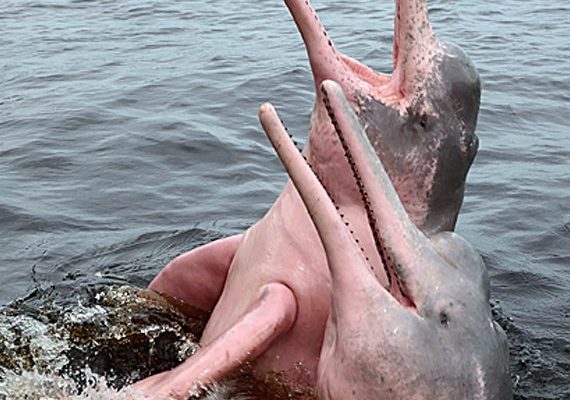
Imagine navigating a maze of murky waters, lush vegetation, and unpredictable currents. That’s the world of the Amazon river dolphin! It’s not just about survival; it’s about mastering their environment. From their physical traits to their behaviors, each adaptation plays a crucial role in their life beneath the surface. So, grab your coffee, and let’s dive into the incredible adaptations that help the Amazon river dolphin swim smoothly through life in their watery home.
Unique Physical Adaptations
The Amazon river dolphin looks like a blend of grace and strength. Their bodies are unlike any other dolphin species. One standout feature is their flexible spine, which allows them to twist and turn with remarkable ease. Picture yourself trying to navigate through a crowded dance floor; you need to be nimble, right? That’s how these dolphins move through their environment, dodging obstacles like submerged tree trunks and thick vegetation.
Another key adaptation is their pink coloration. While they might not be the rainbow-hued creatures of cartoons, their pink hue serves a purpose. This color helps them blend into their environment. In muddy waters, being lighter may make it easier for them to avoid predators while also hunting for food. It’s like wearing the perfect camouflage outfit to go undetected during a game of hide and seek.
But that’s not all! Their bodies also have thick blubber for insulation. Freshwater can be surprisingly chilly, especially during the cooler months. Having an extra layer of fat helps them maintain their body temperature. Just think about how we bundle up in warm clothes during winter. These dolphins rely on their blubber to stay cozy in the water.
Specialized Echolocation Abilities
One of the most remarkable adaptations of the Amazon river dolphin is its ability to use echolocation. This is like a built-in GPS system that allows them to navigate and hunt in murky waters. Imagine shouting in a cave and listening to the echoes that bounce back. That’s how these dolphins locate objects and prey around them.
Unlike many ocean dolphins that often rely on sight, Amazon river dolphins have adapted to low visibility. Their echolocation clicks can travel through the water, bouncing off objects and returning to them, painting an acoustic picture of their surroundings. This ability is crucial for finding fish and navigating tight spots.
Moreover, they can adjust the frequency of their clicks. This means they can focus on hunting for specific types of prey. It’s a bit like fine-tuning a radio to get just the right station. The ability to adapt their clicks allows them to thrive in the diverse environments of the Amazon basin, finding food even when visibility is near zero.
Behavioral Adaptations
Behavior plays a big role in how Amazon river dolphins thrive underwater. These docile creatures are known for being highly social. They often form small groups, known as pods, which can consist of up to 20 dolphins. Working together helps them hunt more effectively and offers social interactions. Imagine having a team to play a game with; it’s just more fun and successful that way!
In addition, these dolphins have also shown curiosity and intelligence in their interactions with humans. Unlike some other animals, they don’t shy away from people. They often approach boats, sometimes swimming alongside them. This curiosity may help them learn about their environment and the potential dangers that may come from human activity.
Moreover, their playful nature has been observed in behaviors like jumping and surfacing with remarkable agility. These actions aren’t just for fun—they’re essential for communication, social bonding, and even practice for hunting skills. Just think of it as kids playing games in the playground. It’s crucial for their growth and development!
Feeding Adaptations
When it comes to feeding, the Amazon river dolphin is quite the opportunistic eater. They primarily feed on fish, but they’re not picky; they’ll eat whatever is readily available. Their broad, flat teeth help them grasp slippery prey, similar to how we use our hands to hold onto a ball. When you’re in an environment like the Amazon, where food can be unpredictable, being adaptable is key.
Interestingly, they have a unique feeding technique called “fish-whacking.” This involves striking fish with their bodies or tails to stun them. Imagine trying to catch a small, wiggly fish with your bare hands—you’d have to find ways to outsmart it! By using this technique, they increase their chances of a successful meal, showcasing their clever hunting strategies.
They often hunt near the bottom of the river or among the roots of trees, demonstrating their ability to adapt to varying habitats. This behavior allows them to access a range of prey that many other predators might miss. In a way, it’s like knowing all the good hiding spots for snacks in your kitchen!
Adaptations to Freshwater Life
Living in freshwater presents its own set of challenges, and the Amazon river dolphin has made some key adaptations to thrive in this environment. For starters, their kidneys are highly efficient at filtering out impurities in the water. Since freshwater can have fluctuating levels of salinity and pollution, being able to stay hydrated and healthy is vital.
Another significant adaptation is their tolerance for low oxygen levels. Unlike ocean waters, freshwater can sometimes have lower oxygen content, particularly in warmer months. These dolphins can thrive in such conditions, allowing them to explore regions where other species might struggle. It’s like having a special talent that sets you apart from everyone else at a school event!
They also have excellent vision that functions well in low light and murky waters, giving them the edge over potential competitors. This ability to see well in not-so-clear conditions is crucial for spotting prey and navigating their surroundings effectively. It’s like having night-vision goggles when all you have is a flashlight!
Conservation Challenges and Adaptations
Despite their impressive adaptations, Amazon river dolphins face numerous challenges due to human activity. Deforestation, pollution, and fishing practices threaten their habitats and food sources. Many people might wonder, “How can we help?” and the answer lies in understanding these intelligent creatures and the ecosystems they inhabit.
Efforts are being made to promote sustainable fishing practices and habitat protection. Engaging in conservation efforts helps ensure that the rivers remain a safe haven for these dolphins and many other species that share their habitat. Every little action counts, like supporting local conservation groups or spreading awareness about the issues at hand.
Additionally, ecotourism plays a role in raising awareness about these dolphins. Responsible tourism can provide funding for conservation efforts while simultaneously educating people about the importance of protecting their environment. By sharing the story of the Amazon river dolphin, we empower others to care about their future.
The adaptations that help the Amazon river dolphin thrive underwater are a fascinating mix of physical traits, behaviors, and innovative feeding strategies. From their agile bodies to their clever use of echolocation, each characteristic plays a vital role in their survival in a challenging environment.
As we learn more about these remarkable creatures, it’s essential to remember that their future relies on our actions today. By promoting awareness and conservation, we can help ensure that future generations will be able to marvel at the wonders of the Amazon and its incredible inhabitants. So, let’s celebrate the Amazon river dolphin and commit to protecting their watery world!

